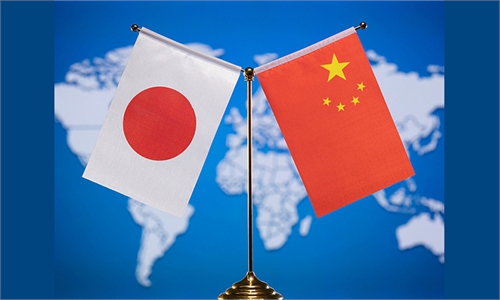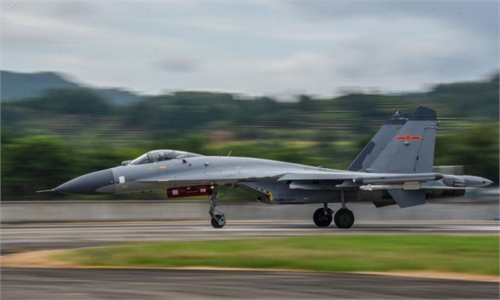US, Australia lead joint drills to flex muscles, upend regional stability amid tensions in Taiwan Straits
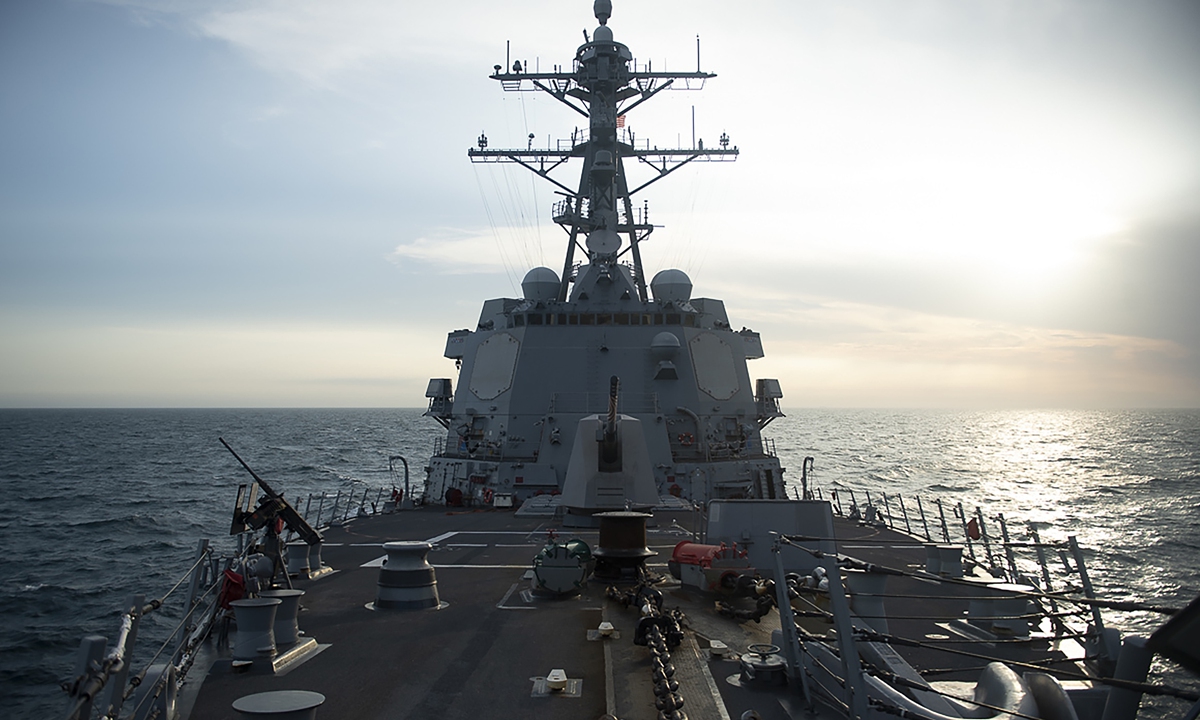
The guided-missile destroyer USS Sampson sailed through the Taiwan Straits on April 26, 2022. Photo:VCG
Exercise Pitch Black, a military drill participated in by the US, Australia and other 15 countries, reportedly started on Friday with the US' purpose being to pull more countries into an anti-China united frontline and show the "unity" of the West to pressure China over the Taiwan question. However, analysts noted that it is impossible for the US to form an alliance through one military exercise as participants have no shared goal and frequent US-led military drills will destabilize the regional environment.
This year's Exercise Pitch Black will run from Friday to September 8, and over 100 aircraft and 2,500 personnel from Australia, Canada, France, Germany, Indonesia, India, Japan, Malaysia, the Netherlands, New Zealand, the Philippines, South Korea, Singapore, Thailand, the UAE, US and UK will take part, in an effort to "enhance interoperability and develop strong relations between participating military forces," according to the Australian air force.
According to information from Australia, the exercise will include day and night flying. It will be conducted in the Northern Territory of Australia, with forces primarily based from RAAF Base Darwin and RAAF Base Tindal.
Analysts pointed out that Exercise Pitch Black is a biennial multinational exercise and it was suspended for some years due to the COVID-19 pandemic. The last one was held in 2018.
This year, it restarted on a larger scale, with participants coming from North America, Europe, Asia and the Middle East, and it may add oil to the flames as the Asia-Pacific region is experiencing instability with the US' rampant provocations in the region.
They noted that in 2018, 12 countries participated in the exercise while this year, the number expanded to 17, and as the host, Australia worked hard to invite more countries to join in.
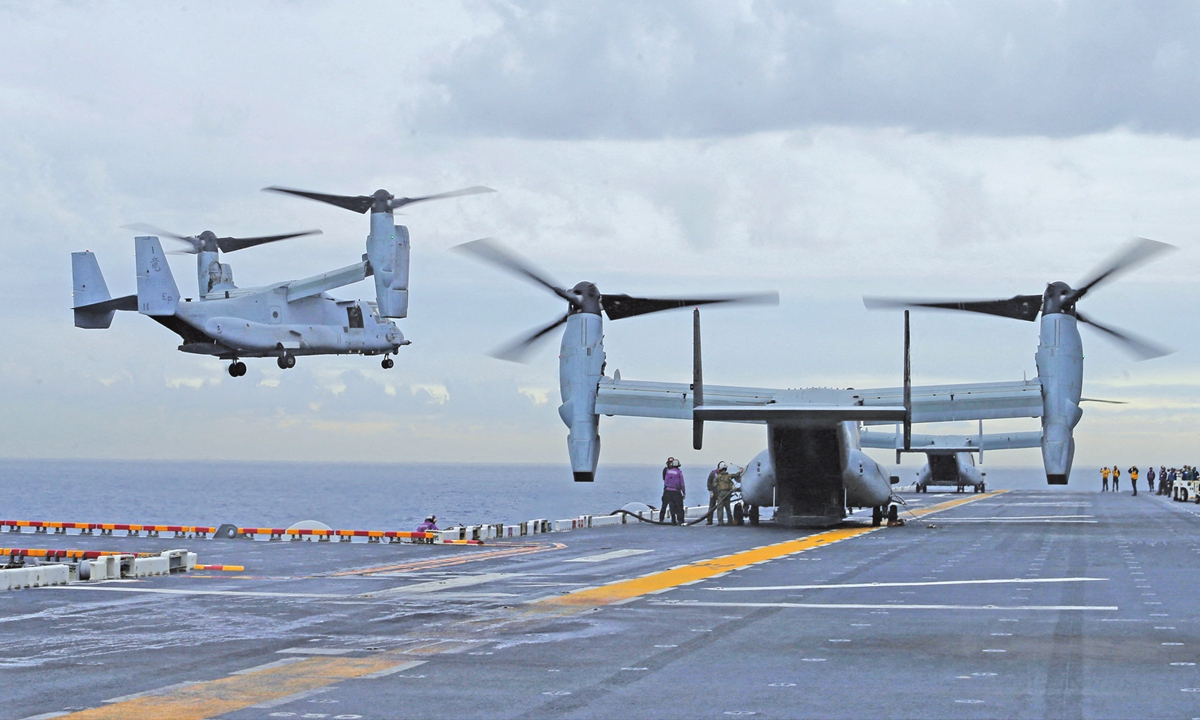
US aircraft land on the deck of the USS Bonhomme Richard amphibious assault ship during a joint military exercise between the US and Australia, off the coast of Sydney on June 29, 2017. Photo: VCG
Australia has always thought of itself as the deputy sheriff to the US in the Asia-Pacific region, and it has the responsibility of defending US hegemony in the region, Yu Lei, chief research fellow at the Research Center for Pacific Island Countries of Liaocheng University, told the Global Times.
In terms of the economy, the US is one of Australia's largest partners; in politics, the US seems to have the greater say in key government appointments; and in military affairs, Australia needs the US to help it maintain dominance in the Pacific region. Without the US, no country will admit Australia's position as deputy sheriff, said Yu.
The Australian air force said in a release that activities such as Exercise Pitch Black "recognize Australia's strong relationships and the high value we place on regional security and fostering closer ties throughout the Indo- Pacific region."
However, Song Zhongping, a Chinese mainland military expert and TV commentator, said that Australia is actually setting fires and bringing trouble to itself, as its bases in the north and west will be used as bridgeheads for the US to counter China, which makes Australia - a country that should be far from disturbances - a more and more unsafe place.
"From the perspective of each participant, not every country comes for political concerns, for example, some Southeast Asian countries may take the exercise as a chance to improve their own capabilities, and some participants may have friction with each other," Zhang told the Global Times.
Song said that the 17 nations did not attend the exercise for a shared goal. For example, Germany, which is attending the drills for the first time, has focused more on Europe.
Song told the Global Times that last year, under pressure from the US and NATO, Germany sent the Brandenburg-class frigate Bayern to the South China Sea to show a military presence in the Asia-Pacific region. Sending planes or ships to the region one time in a year is different from the US' normalizing its military presence around China.
Germany does not totally agree with the eastward expansion of NATO. Its concern in Asia is the huge market, especially the market in China, Song noted.
According to a release from the Australian forces, Japan, and South Korea will also for the first time fully participate in the joint exercise this year, which raised concerns of some analysts about the US' attempt to make an Asian version of the NATO military pact to counter China.
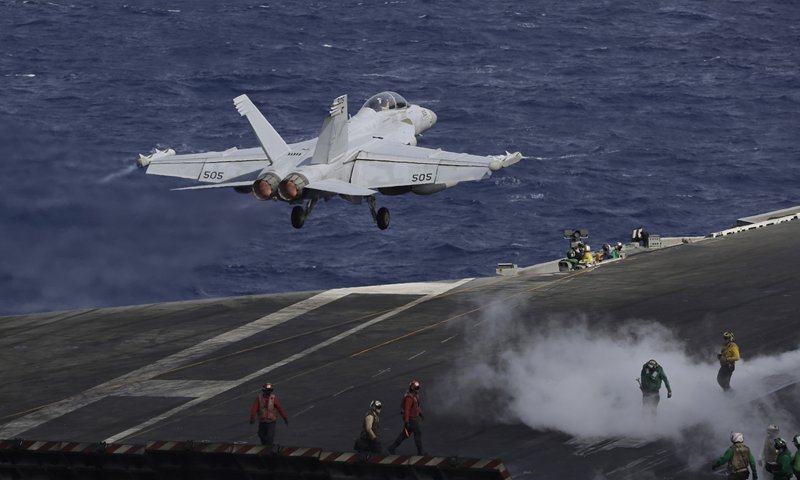
An F/A-18 Super Hornet fighter jet takes off on the deck of the US Navy USS Ronald Reagan in the South China Sea. Photo: AP
The US has always been the primary culprit that destabilizes the Asia-Pacific, said Song, pointing out that after setting up AUKUS with the UK and Australia in 2021, the US attempted to pull Japan, South Korea and some NATO members into AUKUS. Holding military drills by inviting other countries has been the US' tactic to realize the goal.
Recent weeks and the next week have and will witness many military activities among the US and its allies. Aside from Exercise Pitch Black, the US, Japan and South Korea conducted a missile warning and ballistic missile search and tracking exercise during the multinational Pacific Dragon exercise off the coast of the Pacific Missile Range Facility in Hawaii from August 8 to 14, according to media reports.
From August 22 to September 1, the US and South Korea will have their biggest combined military training with potentially tens of thousands of troops involved, US media reported.
Song pointed out that the drills of the US, Japan and South Korea, which have been conducted to deter North Korea, aim to build a global anti-missile system with the capability for offensive and defensive operations, and it targets China and Russia.
Observers said that such frequent military exercises by the US and its allies have worsened the regional situation, making some countries, for example, North Korea, feel unsafe, deteriorating the situation on the Korean Peninsula, and intensifying the arms race in the region.
North Korea announced that it test-fired two cruise missiles into the sea on Wednesday. And in response to South Korean President Yoon Suk-yeol's plan to help North Korea boost its economy if the North gives up nuclear weapons, Kim Yo-jong, vice department director of the Central Committee of the Workers' Party of Korea and younger sister of North Korean top leader Kim Jong-un, said that no one barters its destiny for corn cakes, state news agency KCNA reported.
Although the exercise had been scheduled for a long time, it happened to come amid a strained situation in the Taiwan Straits. The US also wants to flex its muscles to China with allies and show the "unity" of the West, analysts said. However, compared with the total number of countries worldwide, 17 is a small number, let alone the smaller number of US allies.
Against the backdrop of the strained situation in the Taiwan Straits after US House Speaker Nancy Pelosi's highly provocative visit to the island of Taiwan, some Australian and Western media claimed that this year's Exercise Pitch Black represents "an allied response" within the Asia-Pacific to China's military drills around the island of Taiwan.
The US wants to build an anti-China united frontline and show the West's unity under its guidance, but when China is pushed into a corner to take military action related to the island of Taiwan, only a few countries would closely follow it to interfere, Yuan Zheng, deputy director and senior fellow of the Institute of American Studies of the Chinese Academy of Social Sciences, told the Global Times.
Moreover, China's actions to push the reunification process will not be affected by outside forces, and China will only choose the right time to immediately take action and accomplish its mission.
The joint military exercise led by the US in Australia has no influence on China, said Yuan, noting that China may also conduct reconnaissance missions in nearby waters like what the Australia and US did during China's military drills.

